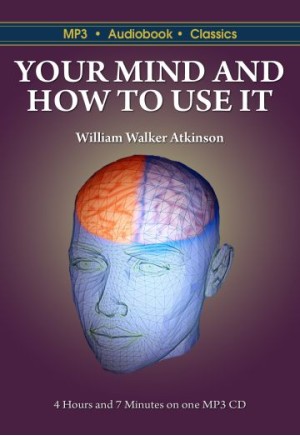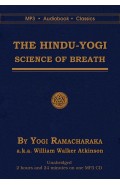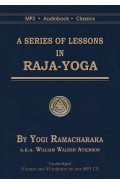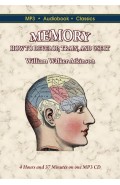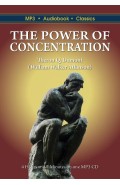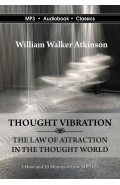| Track | Chapter | Length |
| 1 | 01 - What is the Mind? | 9:24 |
| 2 | 02 - The Mechanism of Mental States | 7:49 |
| 3 | 03 - The Great Nerve Centers | 10:21 |
| 4 | 04 - Consciousness | 6:30 |
| 5 | 05 - Attention | 9:35 |
| 6 | 06 - Perception | 12:32 |
| 7 | 07 - Memory | 12:41 |
| 8 | 08 - Memory (continued) | 10:38 |
| 9 | 09 - Imagination | 14:15 |
| 10 | 10 - The Feelings | 10:43 |
| 11 | 11 - The Emotions | 13:37 |
| 12 | 12 - The Instinctive Emotions | 11:25 |
| 13 | 13 - The Passions | 11:55 |
| 14 | 14 - The Social Emotions | 11:00 |
| 15 | 15 - The Religious Emotions | 9:33 |
| 16 | 16 - The Aesthetic Emotions | 12:17 |
| 17 | 17 - The Intellectual Emotions | 8:50 |
| 18 | 18 - The Role of the Emotions | 7:32 |
| 19 | 19 - The Emotions and Happiness | 9:38 |
| 20 | 20 - The Intellect | 12:10 |
| 21 | 21 - Conception | 9:39 |
| 22 | 22 - Classes of Concepts | 9:20 |
| 23 | 23 - Judgments | 9:40 |
| 24 | 24 - Primary Laws of Thought | 7:04 |
| 25 | 25 - Reasoning | 7:20 |
| 26 | 26 - Inductive Reasoning | 7:25 |
| 27 | 27 - Deductive Reasoning | 11:01 |
| 28 | 28 - Fallacious Reasoning | 11:54 |
| 29 | 29 - The Will | 18:32 |
| 30 | 30 - Will-Training | 8:45 |
| 31 | 31 - Will-Tonic | 8:27 |
Production
Book Coordinator: Algy Pug
Meta Coordinator: Sarah Jennings
Proof Listener: bandbw123
Artwork
Cover: Illustration of human head from pixabay.com
Inset: Title page of first edition of Your Mind and How to Use It
Inset: Photo of William Walker Atkinson
The first chapter of Your Mind and How to Use It (1911) includes a succinct definition of the mind that suggests the difficulty of dealing with something that is abstract by its very nature.
“Mind is defined as “the faculty or power whereby thinking creatures, feel, think, and will.” This definition is inadequate and circular in nature, but this is unavoidable, for mind can be defined only in its own terms and only by reference to its own processes. Mind, except in reference to its own activities, cannot be defined or conceived. It is known to itself only through its activities.”
Fortunately modern psychology has focused on what we can know, and in this book the author “bends all its energies upon discovering the laws of mental activities and states and developing methods whereby the mind may be trained to perform better and more work, to conserve its energies, and to concentrate its forces.” The first section treats the mechanics of the mental states produced by the nervous system, the brain, and the sense organ. The second group describes the facts of consciousness and its planes. The third delves into the many mental processes and faculties that taken together comprise what we think of as “the mind”. It is meant to be a handbook that the reader will use continuously, revisiting sections as understanding enlarges and self-control improves, as countless readers have done for over 100 years.
Play sample:
Download a PDF datasheet
| Item Info | |
| EAN - DVD case | 0701236969702 |
| EAN - CD jacket | 0686175923391 |
| Media | MP3 CD |
| Package | DVD Case |
| Author | William Walker Atkinson (1862-1932) |
| Year | 1911 |
| Recording | |
| Read by | Algy Pug |
| Length | 5 hours 21 minutes |
| Type of Reading | Solo |
Your Mind and How to Use It
- Author: William Walker Atkinson
- Product Code: DB-1250
- Availability: In Stock
-
$9.99
Available Options
Related Products
The Hindu-Yogi Science of Breath
The Hindu-Yogi Science of Breath was published in 1903 by William Walker Atkinson under the pseudony..
$9.99
A Series Of Lessons in Raja Yoga
A Series of Lessons in Raja Yoga is an in-depth yet practical guide to the concepts and practices us..
$9.99
Memory: How to Develop, Train and Use It
When we think of memory we often think of it as an innate mental ability – either you have a good me..
$9.99
The Power of Concentration
You hear it all the time: we live in a fast-paced, omni-connected, always-on world fueled by social ..
$9.99
Thought Vibration: The Law of Attraction in the Thought World
Thought Vibration, or The Law of Attraction in the Thought World (1908) is a collection of lessons t..
$9.99

